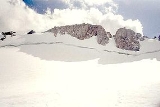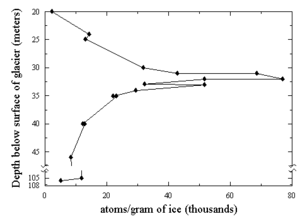
Upper Fremont Glacier
Encyclopedia
Upper Fremont Glacier is located in the Fitzpatrick Wilderness
of Shoshone National Forest
in the U.S. state
of Wyoming
. This Wind River Range
glacier is associated with the largest grouping of glaciers in the U.S. Rocky Mountains and lies on the north slope of Fremont Peak
, the third tallest mountain in Wyoming. Upper Fremont Glacier is at an average altitude of 13450 ft (4,099.6 m) and is one the highest altitude glaciers in the American Rockies.
Ice core
samples were taken from Upper Fremont Glacier in 1990-1991. These ice cores were analyzed for climatic changes as well as alterations of atmospheric chemicals. In 1998 an unbroken ice core sample of 538 ft (164 m) was taken from the glacier and subsequent analysis of the ice showed an abrupt change in the oxygen isotope ratio
oxygen-18
to oxygen-16 in conjunction with what is widely regarded as the end of the Little Ice Age
, a period of cooler global temperatures between the years 1550 and 1850. A linkage was established with a similar ice core study which had been undertaken on the Quelccaya Ice Cap
in Peru
, which also demonstrated the same changes in the oxygen isotope ratio during the same period. The climatic implications from the ice cores taken from both sites support evidence of a sudden global climate change during the mid 19th century.

 Ice cores from the glacier also showed increased levels of Tritium
Ice cores from the glacier also showed increased levels of Tritium
(³H) and chlorine
-36 around the year 1963, which coincides with the peak period of above ground nuclear testing
.
The same ice cores were also tested for Mercury
deposition from natural and human-induced activities. This is the first known instance in which ice cores have been used to determine Mercury deposition from a mid-latitude glacier in North America
, as all previous studies have been derived from other sources. The majority of Mercury deposition is by way of the atmosphere and sources of the element may be from volcanic
activity or from industrialization, but volcanoes contribute a small proportion of the Mercury. The ice core samples from the Upper Fremont Glacier indicated that levels of Mercury increased dramatically during the industrial revolution
and have decreased significantly since the mid 1980s. It is believed that the decrease in Mercury deposition since the 1980s coincides with the passage of the Clean Air Act
.
Fitzpatrick Wilderness
The Fitzpatrick Wilderness is located in Shoshone National Forest in the U.S. state of Wyoming. The wilderness was originally known as the Glacier Primitive Area, but was redesignated a wilderness in 1976....
of Shoshone National Forest
Shoshone National Forest
Shoshone National Forest is the first federally protected National Forest in the United States and covers nearly 2.5 million acres in the state of Wyoming. Originally a part of the Yellowstone Timberland Reserve, the forest was created by an act of Congress and signed into law by U.S....
in the U.S. state
U.S. state
A U.S. state is any one of the 50 federated states of the United States of America that share sovereignty with the federal government. Because of this shared sovereignty, an American is a citizen both of the federal entity and of his or her state of domicile. Four states use the official title of...
of Wyoming
Wyoming
Wyoming is a state in the mountain region of the Western United States. The western two thirds of the state is covered mostly with the mountain ranges and rangelands in the foothills of the Eastern Rocky Mountains, while the eastern third of the state is high elevation prairie known as the High...
. This Wind River Range
Wind River Range
The Wind River Range , is a mountain range of the Rocky Mountains in western Wyoming in the United States. The range runs roughly NW-SE for approximately 100 miles . The Continental Divide follows the crest of the range and includes Gannett Peak, which at 13,804 feet , is the highest peak...
glacier is associated with the largest grouping of glaciers in the U.S. Rocky Mountains and lies on the north slope of Fremont Peak
Fremont Peak (Wyoming)
Fremont Peak is the third highest peak in Wyoming and straddles the boundary between Fremont and Sublette counties. It is named for American explorer John C. Fremont who climbed the peak with Charles Preuss and Johnny Janisse on August 13 to August 15, 1842...
, the third tallest mountain in Wyoming. Upper Fremont Glacier is at an average altitude of 13450 ft (4,099.6 m) and is one the highest altitude glaciers in the American Rockies.
Ice core
Ice core
An ice core is a core sample that is typically removed from an ice sheet, most commonly from the polar ice caps of Antarctica, Greenland or from high mountain glaciers elsewhere. As the ice forms from the incremental build up of annual layers of snow, lower layers are older than upper, and an ice...
samples were taken from Upper Fremont Glacier in 1990-1991. These ice cores were analyzed for climatic changes as well as alterations of atmospheric chemicals. In 1998 an unbroken ice core sample of 538 ft (164 m) was taken from the glacier and subsequent analysis of the ice showed an abrupt change in the oxygen isotope ratio
Oxygen isotope ratio cycle
Oxygen isotope ratio cycles are cyclical variations in the ratio of the abundance of oxygen with an atomic mass of 18 to the abundance of oxygen with an atomic mass of 16 present in some substances, such as polar ice or calcite in ocean core samples. The ratio is linked to water temperature of...
oxygen-18
Oxygen-18
Oxygen-18 is a natural, stable isotope of oxygen and one of the environmental isotopes.18O is an important precursor for the production of fluorodeoxyglucose used in positron emission tomography...
to oxygen-16 in conjunction with what is widely regarded as the end of the Little Ice Age
Little Ice Age
The Little Ice Age was a period of cooling that occurred after the Medieval Warm Period . While not a true ice age, the term was introduced into the scientific literature by François E. Matthes in 1939...
, a period of cooler global temperatures between the years 1550 and 1850. A linkage was established with a similar ice core study which had been undertaken on the Quelccaya Ice Cap
Quelccaya Ice Cap
The Quelccaya Ice Cap is the largest glaciated area in the tropics. Located in the Cordillera Oriental section of the Andes mountains of Peru, the ice cap is at an average altitude of 5,470 meters and spans an area of 44 square kilometers...
in Peru
Peru
Peru , officially the Republic of Peru , is a country in western South America. It is bordered on the north by Ecuador and Colombia, on the east by Brazil, on the southeast by Bolivia, on the south by Chile, and on the west by the Pacific Ocean....
, which also demonstrated the same changes in the oxygen isotope ratio during the same period. The climatic implications from the ice cores taken from both sites support evidence of a sudden global climate change during the mid 19th century.


Tritium
Tritium is a radioactive isotope of hydrogen. The nucleus of tritium contains one proton and two neutrons, whereas the nucleus of protium contains one proton and no neutrons...
(³H) and chlorine
Chlorine
Chlorine is the chemical element with atomic number 17 and symbol Cl. It is the second lightest halogen, found in the periodic table in group 17. The element forms diatomic molecules under standard conditions, called dichlorine...
-36 around the year 1963, which coincides with the peak period of above ground nuclear testing
Nuclear testing
Nuclear weapons tests are experiments carried out to determine the effectiveness, yield and explosive capability of nuclear weapons. Throughout the twentieth century, most nations that have developed nuclear weapons have tested them...
.
The same ice cores were also tested for Mercury
Mercury (element)
Mercury is a chemical element with the symbol Hg and atomic number 80. It is also known as quicksilver or hydrargyrum...
deposition from natural and human-induced activities. This is the first known instance in which ice cores have been used to determine Mercury deposition from a mid-latitude glacier in North America
North America
North America is a continent wholly within the Northern Hemisphere and almost wholly within the Western Hemisphere. It is also considered a northern subcontinent of the Americas...
, as all previous studies have been derived from other sources. The majority of Mercury deposition is by way of the atmosphere and sources of the element may be from volcanic
Volcano
2. Bedrock3. Conduit 4. Base5. Sill6. Dike7. Layers of ash emitted by the volcano8. Flank| 9. Layers of lava emitted by the volcano10. Throat11. Parasitic cone12. Lava flow13. Vent14. Crater15...
activity or from industrialization, but volcanoes contribute a small proportion of the Mercury. The ice core samples from the Upper Fremont Glacier indicated that levels of Mercury increased dramatically during the industrial revolution
Industrial Revolution
The Industrial Revolution was a period from the 18th to the 19th century where major changes in agriculture, manufacturing, mining, transportation, and technology had a profound effect on the social, economic and cultural conditions of the times...
and have decreased significantly since the mid 1980s. It is believed that the decrease in Mercury deposition since the 1980s coincides with the passage of the Clean Air Act
Clean Air Act
A Clean Air Act is one of a number of pieces of legislation relating to the reduction of airborne contaminants, smog and air pollution in general. The use by governments to enforce clean air standards has contributed to an improvement in human health and longer life spans...
.

